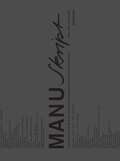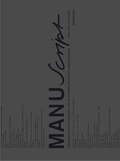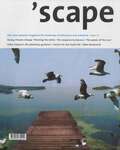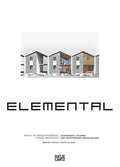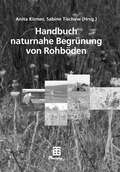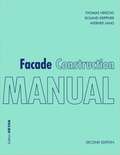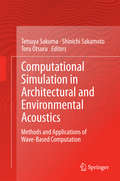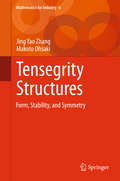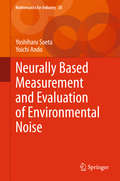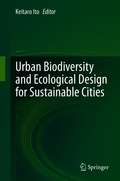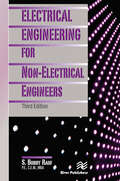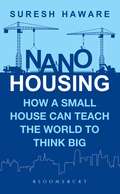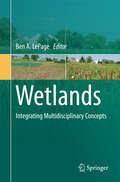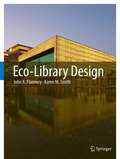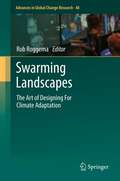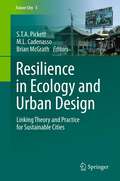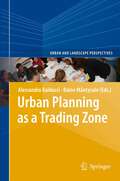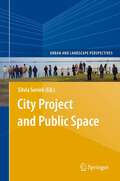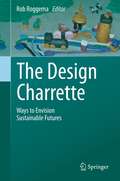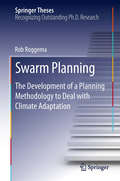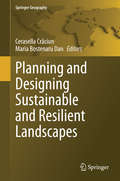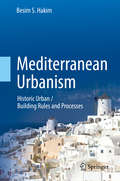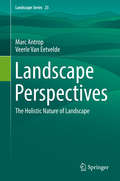- Table View
- List View
Manuskript: Essentials für den Alltag von Innenarchitekten und Designern
by Axel Müller-SchöllDas Buch bietet grundlegende erste Informationen für Innenarchitekten und Designer. Aus den Gebieten der Innenraumgestaltung zu Decken, Fußböden, Wänden, Türen, Fenstern, Treppen etc. Aus der Materialkunde: zu Teppichen, Tapeten, Wandanstrichen, Glas, Holzwerkstoffe, Stein, Beton. Ein weiterer Schwerpunkt ist dem Entwerfen und Aufzeichnen gewidmet: Darstellungstechniken, darstellende Geometrie, technische Zeichnungen, Orientierungsmaße, Zeichen und Symbole und mathematische Grundlagen; hinzu kommen grafische Grundbegriffe, Elemente der Druckvorstufe, Dateiformate und Farbsysteme. Ergänzt und veranschaulicht werden die Informationen mit Praxisbeispielen, originalen Textbeiträgen von Ruedi Baur, Axel Kufus, Norbert Rademacher, Martin Kunz u.a. sowie anregenden Zitaten. Falls der Leser, die Nutzerin des Buches wollen, können die Seiten in Japanbindung aufgetrennt werden: es entsteht so immer wieder Raum für persönlichen Ergänzungen und Notizen.
Manuscript: Essentials for the Everyday Use of Interior Architects and Designers
by Axel Müller-SchöllThis book provides essential introductory information for designers and interior designers. From the realm of interior design, for example, it deals with ceilings, floors, doors, windows, stairs, etc. – from that of material science, with carpets, wallpaper, wall paint, glass, wood materials, stone, and concrete. It also presents architectural drawing: techniques of representation, descriptive geometry, technical drawing, standard dimensions, signs and symbols, and mathematical foundations; attention is also given to the fundamentals of graphic design, preparing documents for publication, file formats, and color systems. All of this is generously leavened with practical examples; original essays by Ruedi Baur, Axel Kufus, Norbert Rademacher, Martin Kunz, and others; and thought-provoking quotations. If they want to, readers may separate the pages of the Japanese binding – this way they get room to add their personal notes and comments.
'scape: The International Magazine of Landscape Architecture and Urbanism (Scape #2/07)
The planning parameters of city planning and landscape architecture are changing as a result of global warming. 'scape 4 presents the most intelligent and exciting designs, and discusses the various possibilities planners have, for working with the changing climate. Designing without water: heat and dryness demand new visions; resource scarcity calls for rethinking. Delta regions are the most densely populated areas in the world. Precisely in these regions the water is rising. In the Netherlands a number of studies and initiatives are investigating what solutions are possible and desirable. Arctic cities are no longer remote, whether economically or in terms of culture or climate. What were once extreme situations can be sensibly developed today. Portrait: The French landscape architect Gilles Clément’s concept of the “jardin planétaire” calls on designers to relate to the earth as a garden. A plea for collective responsibility, poetic and convincing.
Elemental: Incremental Housing and Participatory Design Manual
by Alejandro Aravena Andrés IacobelliWhat began as an academic initiative to improve the quality of life of the poor strata of the population has now become a professional “do tank” offering services that cover the entire spectrum of urban development. The celebrated Chilean architect, winner of the 2016 Pritzker Prize and Director of the 2016 Venice Architecture Biennale, Alejandro Aravena (born 1967) founded Elemental in 2001 in his hometown with the goal of alleviating social deprivation directly instead of hoping for a balance of income relations. Besides building public facilities and public housing, Elemental also develops new approaches for the reorganization of resources and the potential of cities by means of projects devoted to infrastructure and transportation. This volume, first published in 2013 and now back in print, documents the social activity and history of the international architectural team and sheds light on its financing strategies, for example through participatory building.
Elemental
by Alejandro Aravena Andrés IacobelliWhat began as an academic initiative to improve the quality of life of poor strata of the population has meanwhile become a professional “do tank” offering services that cover the entire spectrum of urban development. Alejandro Aravena (*1967 in Santiago de Chile) founded Elemental in 2001 in his hometown with the goal of alleviating social deprivation directly instead of hoping for a balance of income relations. Besides building public facilities and public housing, Elemental also develops new approaches for the reorganization of resources and the potential of cities by means of projects devoted to infrastructure and transportation. This publication documents the social activity and history of the international architectural team and sheds light on its financing strategies, for example through participative building. 15th International Architecture Exhibition, Venice, May 28–November 27, 2016
Handbuch naturnahe Begrünung von Rohböden
by Anita Kirmer Sabine TischewEingriffe in Natur und Landschaft (z. B. Baumaßnahmen, Rohstoffgewinnung, Straßenbau) führen einerseits zu einer nachhaltigen Devastierung von Flächen, die nach Beendigung der Bau- bzw. Abbautätigkeiten wieder in die Landschaft eingegliedert werden müssen, andererseits müssen im Rahmen von Ausgleichs- und Ersatzmaßnahmen naturschutzfachlich wertvolle Flächen geschaffen oder wiederhergestellt werden. In vielen Bereich (z. B. Böschungen) steht dabei Erosionsschutz an erster Stelle. Die in diesem Buch vorgestellten Methoden ermöglichen darüber hinaus eine nachhaltige und standortgerechte Vegetationsentwicklung mit gebietsheimischen Arten. Zum Einsatz kommen dabei ansaatlose Verfahren wie Oberboden- und Mähgutauftrag sowie Mulchdecksaaten mit gebietsheimischem Saatgut. Das Buch ist nach verschiedenen Standortverhältnissen gegliedert, für die geeignete Methoden genau erläutert sowie Beispiele für die jeweiligen Zielzustände gezeigt werden. Der künftige Anwender erhält damit ein übersichtliches Handbuch mit Handlungsanweisungen für unterschiedliche Standorte. Die Angaben basieren dabei auf den neuesten wissenschaftlichen Erkenntnissen (u. a. SURE-Projekt).
Facade Construction Manual: (pdf) (Detail Construction Manuals Ser.)
by Thomas Herzog Roland Krippner Werner LangThe facade in the 21st century In recent years, facades have become more important in architectural practice and in public perception. As well as functioning as a protective shell and visible 'face' and supplying heat and electricity, a building's exterior interacts directly with the surrounding public space. This revised and expanded new edition of the Facade Construction Manual offers readers technical and design planning fundamentals in a compact reference work. A section describing a comprehensive selection of built structures shows general and unique, tried and tested, and innovative approaches to facade planning – down to the last detail. Over 100 examples of built structures Material-specific approaches for use in planning facades Technical planning fundamentals Special issues involving modern facade concepts
Computational Simulation in Architectural and Environmental Acoustics: Methods and Applications of Wave-Based Computation
by Tetsuya Sakuma Shinichi Sakamoto Toru OtsuruThis book reviews a variety of methods for wave-based acoustic simulation and recent applications to architectural and environmental acoustic problems.Following an introduction providing an overview of computational simulation of sound environment, the book is in two parts: four chapters on methods and four chapters on applications. The first part explains the fundamentals and advanced techniques for three popular methods, namely, the finite-difference time-domain method, the finite element method, and the boundary element method, as well as alternative time-domain methods. The second part demonstrates various applications to room acoustics simulation, noise propagation simulation, acoustic property simulation for building components, and auralization.This book is a valuable reference that covers the state of the art in computational simulation for architectural and environmental acoustics.
Tensegrity Structures: Form, Stability, and Symmetry (Mathematics for Industry #6)
by Jing Yao Zhang Makoto OhsakiTo facilitate a deeper understanding of tensegrity structures, this book focuses on their two key design problems: self-equilibrium analysis and stability investigation. In particular, high symmetry properties of the structures are extensively utilized. Conditions for self-equilibrium as well as super-stability of tensegrity structures are presented in detail. An analytical method and an efficient numerical method are given for self-equilibrium analysis of tensegrity structures: the analytical method deals with symmetric structures and the numerical method guarantees super-stability. Utilizing group representation theory, the text further provides analytical super-stability conditions for the structures that are of dihedral as well as tetrahedral symmetry. This book not only serves as a reference for engineers and scientists but is also a useful source for upper-level undergraduate and graduate students. Keeping this objective in mind, the presentation of the book is self-contained and detailed, with an abundance of figures and examples.
Neurally Based Measurement and Evaluation of Environmental Noise (Mathematics for Industry #20)
by Yoshiharu Soeta Yoichi AndoThis book deals with methods of measurement and evaluation of environmental noise based on an auditory neural and brain-oriented model. The model consists of the autocorrelation function (ACF) and the interaural cross-correlation function (IACF) mechanisms for signals arriving at the two ear entrances. Even when the sound pressure level of a noise is only about 35 dBA, people may feel annoyed due to the aspects of sound quality. These aspects can be formulated by the factors extracted from the ACF and IACF. Several examples of measuring environmental noise—from outdoor noise such as that of aircraft, traffic, and trains, and indoor noise such as caused by floor impact, toilets, and air-conditioning—are demonstrated. According to the noise measurement and evaluation, applications for sound design are discussed. This book provides an excellent resource for students, researchers, and practitioners in a wide range of fields, such as the automotive, railway, and electronics industries, and soundscape, architecture, and acoustics.
Urban Biodiversity and Ecological Design for Sustainable Cities
by Keitaro ItoThis book highlights various designs for urban green spaces and their functions. It provides an interesting meeting point between Asian, European and North America specialists (researchers, planners, landscape architects) studying urban biodiversity; urban biodiversity and green space; relations between people and biodiversity. The most important feature of this book is the unique point of view from each contributor towards “the relationship between nature and people in urban areas”, in the context of the ecosystem and biodiversity in urban areas and how to manage them. All chapters explore and consider the relationship between humans and nature in cities, a subject which is taking on increasing importance as new cities are conceptualized and planned. These discussion and examples would be useful for urban ecology researchers, biologists, city planners, government staff working in city planning, architects, landscape architects, and university instructors. This book can also be used as a textbook for undergraduate and postgraduate city planning, architecture or landscape architecture courses.
Electrical Engineering for Non-Electrical Engineers
by S. Bobby RaufEngineers and non-engineers often eschew electrical engineering because it is premised on concepts and mathematical techniques that are somewhat more abstract and elusive than those employed in disciplines like civil, mechanical, and industrial engineering. Yet, because of the ubiquitous nature of electrical and electronic equipment and devices, and the indispensable role electricity plays in various facets of lives, a basic understanding of electrical engineering is essential. Engineers and non-engineers find themselves interfacing with electrical apparatus and dealing with matters that permeate into the electrical realm. Therein lies the purpose and objective of this book. This edition includes numerous updated pictures, diagrams, tables, charts, graphs, and improved explanation of certain concepts.
Ecology, Cognition and Landscape: Linking Natural and Social Systems (Landscape Series #11)
by Almo FarinaIt is more and more evident that our living system is completely disturbed by human intrusion. Such intrusion affects the functioning of entire systems in ways we do not yet fully understand. We use paradigms such as the disturbance to cover large and deep gaps in our scienti?c knowledge. Human ecology is an uncertain terrain for anthropologists, geographers, and ecologists and rarely is expanded to include the social and economic realms. The integration of different disciplines and the application of their many paradigms to problems of environmental complexity remains a distant goal despite the many efforts that have been made to achieve it. Philosophical and semantic barriers are erected when such integration is pursued by pioneering scientists. Recently, evolutionary ecology has shown great interest in the spatial processes well described by the emerging discipline of landscape ecology. But this interest takes the form of pure curiosity or at worst, of skepticism toward the real capacity of landscape ecology to contribute to the advancement of ecological science. The past two centuries have been characterized by huge changes occurring in the entire ecosphere. Global changes are the effects of human intervention at a planetary scale, with consequent degradation of the environment creating an e- logical debt for future generations. On the other side of the issue, new technologies have improved the welfare of billions of people and have given hope to many other billions that they may also see such improvement in the near future.
Nano Housing: How a Small House Can Teach the World to Think BIG
by Suresh HawareThink big, act small… Act now… Many of us think big but fail to micro plan. Others get stuck at micro-planning, missing the 'big picture' of what impacts us nationally and globally. Housing is a basic necessity of human beings across the globe, and not just in India. Affordable housing for the masses is a key challenge for governments and policy makers. In Nano Housing, Dr Suresh Haware brings out a detailed study and offers solutions for the housing needs of India and its states and cities. A path-breaking and time-tested concept, nano housing is the outcome of an in-depth practical research which has the potential to fulfill the dream of the common man-an affordable house at an affordable price. Further, the book addresses the impact of GST, RERA and demonetisation on real estate; analyses REIT, home finance and rental housing; and voices the concern of homeless people, unauthorised housing, redevelopment and many other aspects of housing. An innovative and revolutionary idea, Nano Housing is a must-read for all businessmen in general and professionals, economists, sociologists, officials and policy makers engaged in the housing industry in particular.
Wetlands: Integrating Multidisciplinary Concepts
by Ben A. LePageThe science of wetlands and our understanding of these complex ecosystems have improved considerably. The emergence of multidisciplinary strategies is providing new opportunities and innovative approaches to address issues such as climate change and coastal protection. This book, with contributions from 19 specialists from academia, government, and industry, provides a trans-disciplinary approach to the understanding wetlands science, drawing together a wide range of expertise. Topics covered include the physical aspects that shape different wetlands around the world, as well as wetlands ecology, regulation, policy, and related social and economic issues.Featuring contributions from some of the world’s leading wetlands researchers and practitioners, this book provides an invaluable resource for undergraduate and post-graduate training in all aspects of wetlands management, conservation, and construction. It is also a useful auxiliary text for researchers working across disciplines in fields such as wetlands science, law, landscape architecture, environmental engineering, conservation ecology, and related disciplines.
Eco-Library Design
by John A. Flannery Karen M. SmithThe ancient pairing of architecture and books has always been an interesting topic for debate, and the increasing popularity of electronic books has recently added fuel to the fire. However, the bonfires built for the printed version remain unlit. Research undertaken for this publication suggests that the traditional reading room is currently enjoying a renaissance in many different guises, with print and digital media enjoying a symbiotic relationship. The digital revolution is just one of the many challenges faced by the library architect. To satisfy the varied requirements of library users, flexible, future proof, indoor and outdoor spaces must now support both passive and active pursuits. These often contrasting demands can vary dramatically from quiet, contemplative reading to audible public performance. This publication explores in detail the evolution of the eco-library, focusing on how design teams cope with diminishing resources in diverse geographic and climatic conditions. The featured projects demonstrate measurable reductions in both construction and operating costs through innovative designs that utilise the ecology of a selected site in a positive way. A library development will now inevitably seek to lead by example, visibly demonstrating sound environmental practice, and providing an enhanced user experience for increasingly more discerning patrons. Eco-Library Design provides a worldwide perspective on 21st century trends in library architecture.
Swarming Landscapes: The Art of Designing For Climate Adaptation (Advances in Global Change Research #48)
by Rob RoggemaThis book advocates a fresh approach to planning that anticipates, rather than reacts to, the changes in climate currently in process. Today’s spatial planning procedures rely on historical evidence instead of preparing for factors that by definition lie in the future, yet which are relatively uncontroversial: shortages of water, sea level rise and rises in average temperatures being but three examples. Arguing for more flexibility, the contributors view ‘complexity’ as the key to transforming the way we plan in order to better equip us to face uncertainties about our future environment.
Resilience in Ecology and Urban Design: Linking Theory and Practice for Sustainable Cities (Future City #3)
by S.T.A. Pickett, M.L. Cadenasso and Brian McGrathThe contributors to this volume propose strategies of urgent and vital importance that aim to make today’s urban environments more resilient. Resilience, the ability of complex systems to adapt to changing conditions, is a key frontier in ecological research and is especially relevant in creative urban design, as urban areas exemplify complex systems. With something approaching half of the world’s population now residing in coastal urban zones, many of which are vulnerable both to floods originating inland and rising sea levels, making urban areas more robust in the face of environmental threats must be a policy ambition of the highest priority.The complexity of urban areas results from their spatial heterogeneity, their intertwined material and energy fluxes, and the integration of social and natural processes. All of these features can be altered by intentional planning and design. The complex, integrated suite of urban structures and processes together affect the adaptive resilience of urban systems, but also presupposes that planners can intervene in positive ways. As examples accumulate of linkage between sustainability and building/landscape design, such as the Shanghai Chemical Industrial Park and Toronto’s Lower Don River area, this book unites the ideas, data, and insights of ecologists and related scientists with those of urban designers. It aims to integrate a formerly atomized dialog to help both disciplines promote urban resilience.
Urban Planning as a Trading Zone (Urban and Landscape Perspectives #13)
by Alessandro Balducci and Raine Mäntysalo'Trading zone' is a concept introduced by Peter Galison in his social scientific research on how scientists representing different sub-cultures and paradigms have been able to coordinate their interaction locally. In this book, Italian and Finnish planning researchers extend the use of the concept to different contexts of urban planning and management, where there is a need for new ideas and tools in managing the interaction of different stakeholders. The trading zone concept is approached as a tool in organizing local platforms and support systems for planning participation, knowledge production, decision making and local conflict management. In relation to the former theses of communicative planning theory that stress the ideals of consensus, mutual understanding and universal reason, the 'trading zone approach', outlined in this book, offers a different perspective. It focuses on the potentiality to coordinate locally the interaction of different stakeholders without requiring the deeper sharing of understandings, values and motives between them. Galison’s commentary comes in the form of the book’s final chapter.
City Project and Public Space (Urban and Landscape Perspectives #14)
by Silvia SerreliThe book aims at nurturing theoretic reflection on the city and the territory and working out and applying methods and techniques for improving our physical and social landscapes. The main issue is developed around the projectual dimension, with the objective of visualising both the city and the territory from a particular viewpoint, which singles out the territorial dimension as the city’s space of communication and negotiation. Issues that characterise the dynamics of city development will be faced, such as the new, fresh relations between urban societies and physical space, the right to the city, urban equity, the project for the physical city as a means to reveal civitas, signs of new social cohesiveness, the sense of contemporary public space and the sustainability of urban development. Authors have been invited to explore topics that feature a pluralism of disciplinary contributions studying formal and informal practices on the project for the city and seeking conceptual and operative categories capable of understanding and facing the problems inherent in the profound transformations of contemporary urban landscapes.
The Design Charrette: Ways to Envision Sustainable Futures
by Rob RoggemaThis book was written to support community involvement in the design process, to help prevent negative outcomes that can result from a top-down design approach. The combination of community involvement and design is, at least in literature, not very extensive. Although much has been written about stakeholder involvement, this is often not directly related to design processes, which – most importantly – deprives community members of the opportunity to design their desired future themselves. The Design Charrette: Ways to Envision Sustainable Futures provides a theoretical foundation establishing the benefits of organizing a design charrette for community-based planning, supported by many practical examples. The book includes sections on collaborative learning, practical guidance, theory and case studies in many different contexts: long and short charrettes, urban and rural subjects, and Dutch, Chinese, Australian, Indian and European examples. Part I: General Theory offers a detailed overview of the charrette process, a chapter on innovations in organizational and community learning and a chapter on shifting paradigms in the design charrette. Part II presents a number of case studies, including the INternational Conference on Renewable Energy Approaches for the Spatial Environment (INCREASE); charrettes accomplished in two days in the communities of Sea Lake and Bendigo in Australia; a chapter on lessons for the future, describing rural participatory design in Rajasthan, India; a description of learning by practice in a high-pressure student atelier; a chapter entitled Design Charrettes for Sustainable Building in China and more. The Design Charrette challenges the conventional wisdom that good design by itself will bring about the benefits the designer envisions. By demonstrating and analyzing the effectiveness of design charrettes in personal development and learning, and as a way to share desired future pathways, the book benefits everyone who may be leading, considering or participating in a design charrette.
Swarm Planning: The Development of a Planning Methodology to Deal with Climate Adaptation (Springer Theses)
by Rob RoggemaThis book shows that the problem of climate adaptation, which is described in social planning terms as ‘wicked,’ is at odds with the contemporary practice of spatial planning. The author proposes a new adjusted framework which is more adaptable to unpredictable, wicked, dynamic and non-linear processes. The inspiration for this new method is the behaviour of swarms: bees, ants, birds and fish are capable of self-organization, which enables the system to become less vulnerable to sudden environmental changes. The framework proposed in Swarm Planning consists of these four elements: Two levels of complexity, the first being the whole system and the second its individual components. Each of these has different attributes for adapting to change. Five layers, consisting of networks, focal points, unplanned space, natural resources and emerging occupation patterns. Each layer has its own spatial dynamic, and each is connected to a spatial scale. Non-linear processes, which emerge in different parts of the framework and include emerging patterns, connectedness and tipping points among others. Two planning processes; the first, ‘from small to large’ works upward from the slowest changing elements to more rapidly-changing ones. The second, ‘on the list of partners’ addresses each layer from networks through emerging occupation patterns. Swarm Planning applies this framework to a series of pilot studies, and appraises its performance using criteria for an adaptive landscape. The results show that the use of the Swarm Planning Framework reduces the vulnerability of landscapes as well as the impact of climate hazards and disasters, improves response to unexpected hazards and contains adaptation strategies. “This book is a must for planners in government and the private sector as it outlines the concept, strategies and techniques for swarm planning. It is also an important guide for policymakers looking to engage communities in a dialogue about the adaptation planning process.”Professor John Martin, La Trobe University “The ultimate value of the book lies in encouraging the planning community to consider options that go far beyond those offered by business-as-usual planning methodologies developed for a set of operating conditions that are fast becoming obsolete. As such it makes an important and much needed contribution to the field.”Assistant Professor Dr. Chrisna du Plessis, University of Pretoria
Planning and Designing Sustainable and Resilient Landscapes (Springer Geography)
by Cerasella Crăciun Maria Bostenaru DanThis book deals with planning issues in landscape architecture, which start at the evaluation of the existing fabric of society, its history and memory, approached and conserved through photography, film and scenographic installations, a way in which the archetypes can be investigated, be it industrial derelict sites or already green spaces and cultural landscapes. It provides approaches to intervention, through rehabilitation and upgrade, eventually in participative manner. To such evaluation and promotion a couple of disciplines can contribute such as history of art, geography and communication science and of course (landscape) architecture. The field of landscape architecture reunites points of view from such different disciplines with a view to an active approach a contemporary intervention or conservation. The book presents case studies from several European countries (Romania, Germany, Austria, Italy, Portugal) mostly for large landscape in the outskirts of the cities and in the parks.
Mediterranean Urbanism: Historic Urban / Building Rules and Processes
by Besim S. HakimThis book brings together historic urban / building rules and codes for the geographic areas including Greece, Italy and Spain. The author achieved his ambitious goal of finding pertinent rules and codes that were followed in previous societies for the processes that formed the built environment of their towns and cities, including building activities at the neighborhood level and the decision-making process that took place between proximate neighbors. The original languages of the texts that were translated into English are Greek, Latin, Italian, Arabic and Spanish. The sources for the chapter on Greece date from the 2nd century B.C.E. to the 19th century C.E. Those for the chapter on Italy date from the 10th to the 14th centuries C.E. and for the chapter on Spain from the 5th to the 18th centuries C.E. Numerous appendices are included to enhance and elaborate on the material that make up the chapters. This book provides lessons and insights into how compact and sustainable towns and cities that are greatly admired today were achieved in the past and how we and future generations can learn from this rich heritage, including the valuable insight provided by the nature of the rules and codes and their application through centuries of continuous use.
Landscape Perspectives: The Holistic Nature of Landscape (Landscape Series #23)
by Marc Antrop Veerle Van EetveldeClimb a mountain and experience the landscape. Try to grasp its holistic nature. Do not climb alone, but with others and share your experience. Be sure the ways of seeing the landscape will be very different. We experience the landscape with all senses as a complex, dynamic and hierarchically structured whole. The landscape is tangible out there and simultaneously a mental reality. Several perspectives are obvious because of language, culture and background. Many disciplines developed to study the landscape focussing on specific interest groups and applications. Gradually the holistic way of seeing became lost. This book explores the different perspectives on the landscape in relation to its holistic nature. We start from its multiple linguistic meanings and a comprehensive overview of the development of landscape research from its geographical origins to the wide variety of today’s specialised disciplines and interest groups. Understanding the different perspectives on the landscapes and bringing them together is essential in transdisciplinary approaches where the landscape is the integrating concept.
